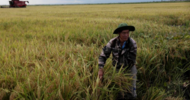Viewing cable 08SHENYANG138, SUBJECT: CHINA,S SUCCOTASH SECURITY-PLENTY OF CORN
If you are new to these pages, please read an introduction on the structure of a cable as well as how to discuss them with others. See also the FAQs
| Reference ID | Created | Released | Classification | Origin |
|---|---|---|---|---|
| 08SHENYANG138 | 2008-09-29 06:44 | 2011-08-30 01:44 | CONFIDENTIAL | Consulate Shenyang |

VZCZCXRO3714 PP RUEHCN RUEHGH RUEHVC DE RUEHSH #0138/01 2730644 ZNY CCCCC ZZH P 290644Z SEP 08 FM AMCONSUL SHENYANG TO RUEHC/SECSTATE WASHDC PRIORITY 8510 INFO RUEHOO/CHINA POSTS COLLECTIVE PRIORITY RUEAIIA/CIA WASHDC PRIORITY 0147 RUEATRS/DEPT OF TREASURY WASH DC PRIORITY 0227 RHEHAAA/NSC WASHDC PRIORITY RUCPDOC/DEPT OF COMMERCE WASHINGTON DC PRIORITY 0817
C O N F I D E N T I A L SECTION 01 OF 02 SHENYANG 000138 SIPDIS DEPT PLEASE PASS TO DEPARTMENT OF AGRICULTURE E.O. 12958: DECL: 09/29/2018 TAGS: CH EAGR ECON PREL EIND EINT ELAB ENRG ETRD PGOV SUBJECT: SUBJECT: CHINA,S SUCCOTASH SECURITY-PLENTY OF CORN (INCLUDING FOR EXPORTS TO NORTH KOREA) BUT NOT ENOUGH BEANS REF: A. SHENYANG 000014 ¶B. SHENYANG 000251 ¶C. BEIJING 009696 ¶D. STATE 99968 Classified By: CONSUL GENERAL STEPHEN B. WICKMAN, Reasons 1.4 B and D ¶1. (C) Summary. Jilin Grain, a key enterprise in China,s drive for grain security, sees continued price pressure in soy beans and oil. Jilin and other corporate entities in China are taking major steps to increase the amount of China-controlled soy plantation both in China and around the world. The corn picture for China is much brighter according to Jilin Grain, as improved technology and good weather more than compensate for a decrease in corn plantation. China will loosen export controls on corn to service demand in Taiwan and North Korea, but otherwise will remain a non-exporter of grain. End Summary. ¶2. (C) Vice-General Manager Feng Jilong of Jilin Grain Group, China,s largest grain company, told Econoff Septermber 17 that while China faced some pricing pressure in its domestic grain market -- largely due to increased costs for seed and fertilizer and also becauseof rising demand -- China is self-sufficient in grains and will not be overly influenced by the recent high global commodity prices. Feng pointed out that international spot market prices for rice are three times China's domestic price, while corn and wheat are nearly twice as high in the ternational market. Only in soy beans and soy oil do global commodity prices impact China's domestic market, Fend stressed. Unlike Western definitions, which class soy as an oil seed, China,s concept of grain includes soy beans and soy oil as an integral component. According to Feng, soy is a key element in China,s grain security strategy. ¶3. (C) Jilin Grain was the major purchaser for this summer,s widely reported USD 450 million purchase of soy beans in the U.S. market and, according to Feng, is likely to be the lead agency for China,s participation in international grain markets. In June, Jilin Grain also dispatched personnel to Zambia to lease major amounts of arable land for soybean production. However, Feng said plans to set up a crushing facility in Johannesburg were scrapped due to political instability in South Africa. (Jilin staff had the misfortune to visit South Africa during this summer,s outbreak of violence toward foreigners.) The African crop will be traded in the regional market with the end goal of freeing up supply elsewhere for China,s consumption. ¶4. (C) Additionally, private soy farmers in Heilongjiang Province have negotiated leases for large tracts of land in Russia,s Amur Province, according to Feng. These areas will be farmed by Chinese workers and the harvest will be shipped to China. Feng added that although current measures have been adequate to ensure the supply of soy beans, major problems remain in getting the beans crushed and the oil to market. With most of the crushing in China controlled by western firms, it is impossible to get them to deliver oil to China,s market at prices below the world market. Feng explained that major state-owned producers, including Jilin Grain,s processing arm, would be forced to absorb losses in the cooking oil market in order to maintain price stability. He said that China would make a major push to increase the crushing capacity of state-owned firms. According to Feng, central government officials are anxious to avoid shortages of cooking oil similar to the shortages of diesel fuel earlier this year without raising prices. The only way to do this is to have state-owned firms absorb the losses, he made clear. (Feng noted that unlike the petroleum producers, which had resisted operating at a loss because they had listed on the Hong Kong and Shanghai markets, Jilin Grain was still unlisted and had to absorb the loss.) ¶5. (C) With regard to corn and rice, Feng told Econoff that the dilemma for China is to balance the need to control prices in the face of rising domestic demand with the need to provide farmers sufficient return on their investment. The spring 2008 central government increase in the rice price was not enough to ensure adequate rice production according to Feng. Thus, the government this year provided free equipment such as tillers and small tractors to marginal rice farming operations throughout China. ¶6. (C) Feng said corn was in an interesting position this SHENYANG 00000138 002 OF 002 year. Overall corn acreage decreased by a full percentage point from last year's levels, due to a government pricing policy that encouraged planting of soy at the expense of corn. However, better planting techniques coupled with exceptionally good weather led to a bumper corn crop. Jilin Grain estimates that production in Jilin Province will be up more than ten percent, while Heilongjiang will slightly exceed last year,s levels with substantially less acreage planted. Northeastern China is expecting a total yield of 160 million metric tons of corn this year. ¶7. (C) The government will take a very active approach to managing the corn market as a key to its grain security strategy, Feng continued. First the government will buy and store as much corn as is necessary to maintain domestic price floors and ensure that farmers have an incentive to plant. Secondly, China will strictly limit the amount of corn devoted to industrial use, storing part of the saved grain and directing the rest for use in animal feed. China plans to price feed corn at levels necessary to keep pig farmers active. Feng said the government wants to prevent last years radical drop in pork production, which eventually led to shortages and major price increases in the retail pork market. As long as wheat prices stay relatively low, Feng explained, wheat would be the preferred feed for the poultry industry. However, if wheat prices jump, central authorities would release corn for the poultry market as well. ¶8. (C) China maintained a stock of about 6.7 million tons of corn during the previous year, according to Feng, an amount that will increase to at least 10 million tons. This would make government stores the third largest demand input, after livestock feed and industrial use, but surpass corn for human consumption. China will use rampant industrial demand as another market control mechanism by permitting more industrial use if an abundant harvest puts too much downward pressure on prices. ¶9. (C) Feng also noted that China plans to maintain most of its corn stock in Northern China, with twenty to thirty percent in Beijing, and roughly fifteen percent in Dalian, Jinzhou, and Bayuquan respectively. Shekou and Zhangzhou in the South will store the remainder. ¶10. (C) While China has generally stuck to its self-imposed elimination of exports (ref B), the bumper corn crop will allow substantial modification to that policy. According to Feng, large quantities of corn will be exported over the next year, but only to Taiwan and North Korea. Shipments to Taiwan are not really exports, Feng explained. He went on to say the shipments to North Korea will likely be in the form of humanitarian assistance, although the press will report these as sales. When pressed as to how large the shipments to North Korea might be, Feng said it was &unlikely that North Korean requests would be denied or reduced.8 Feng suggested that if supplies are as large as hoped, China might actually ship extra corn to North Korea in late 2008 or early ¶2009. ¶11. (C) Econoff,s visits to farms throughout Northeast China indicate that this will indeed be a bumper year for all crops grown in the region. The sunflower crop will also be quite robust this year, and soybeans and corn both appear to be on track for substantial gains over last year,s harvest. China still has plenty of room for increasing yields, however. The most striking visual difference between U.S. farms and those in China is plant density. The Chinese plant row crops much farther apart than their American counterparts. Improved planting equipment and planting methods could substantially increase plant population and thus increase yield. SWICKMAN












